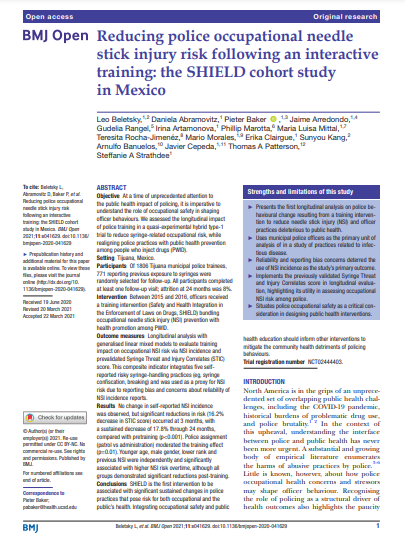Reducing police occupational needle stick injury risk following an interactive training: the SHIELD cohort study in Mexico

Fecha
2021-05-14Autor
Beletsky, Leo
Abramovitz, Daniela
Baker, Pieter
Arredondo, Jaime
Rangel, Gudelia
Artamonova, Irina
Marotta, Phillip
Mittal, Maria Luisa
Morales, Mario
Clairgue, Erika
Kang, Sunyou
Banuelos, Arnulfo
Cepeda, Javier
Patterson, Thomas A.
Strathdee, Steffanie A.
Rocha-Jimenez, Teresita [Univ Mayor, Fac Humanidades, Soc & Hlth Res Ctr, Chile]
Ubicación geográfica
Notas
HERRAMIENTAS
Acceda a títulos restringidos
¿Cómo descargar?Resumen
Objective At a time of unprecedented attention to the public health impact of policing, it is imperative to understand the role of occupational safety in shaping officer behaviours. We assessed the longitudinal impact of police training in a quasi-experimental hybrid type-1 trial to reduce syringe-related occupational risk, while realigning police practices with public health prevention among people who inject drugs (PWID). Setting Tijuana, Mexico. Participants Of 1806 Tijuana municipal police trainees, 771 reporting previous exposure to syringes were randomly selected for follow-up. All participants completed at least one follow-up visit; attrition at 24 months was 8%. Intervention Between 2015 and 2016, officers received a training intervention (Safety and Health Integration in the Enforcement of Laws on Drugs, SHIELD) bundling occupational needle stick injury (NSI) prevention with health promotion among PWID. Outcome measures Longitudinal analysis with generalised linear mixed models to evaluate training impact on occupational NSI risk via NSI incidence and prevalidated Syringe Threat and Injury Correlates (STIC) score. This composite indicator integrates five self-reported risky syringe-handling practices (eg, syringe confiscation, breaking) and was used as a proxy for NSI risk due to reporting bias and concerns about reliability of NSI incidence reports. Results No change in self-reported NSI incidence was observed, but significant reductions in risk (16.2% decrease in STIC score) occurred at 3 months, with a sustained decrease of 17.8% through 24 months, compared with pretraining (p<0.001). Police assignment (patrol vs administration) moderated the training effect (p=0.01). Younger age, male gender, lower rank and previous NSI were independently and significantly associated with higher NSI risk overtime, although all groups demonstrated significant reductions post-training. Conclusions SHIELD is the first intervention to be associated with significant sustained changes in police practices that pose risk for both occupational and the public's health. Integrating occupational safety and public health education should inform other interventions to mitigate the community health detriments of policing behaviours.
URI
https://repositorio.umayor.cl/xmlui/handle/sibum/9078https://www.ncbi.nlm.nih.gov/pmc/articles/PMC8039238/pdf/bmjopen-2020-041629.pdf
https://doi.org/10.1136%2Fbmjopen-2020-041629
https://bmjopen-bmj-com.bibliotecadigital.umayor.cl:2443/sites/default/themes/bmjj/img/icon-pdf.png
Coleccion/es a la/s que pertenece:
Si usted es autor(a) de este documento y NO desea que su publicación tenga acceso público en este repositorio, por favor complete el formulario aquí.